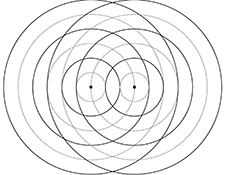
Two-source interference
Variant i Dynamics first Other Variants Interactive tutorial lecture
Developed by Karen Wosilait (creator) and Peter Shaffer (contributor)
The first tutorial on physical optics helps students identify the conditions for maximum constructive interference and complete destructive interference.
Topics Waves and optics / Physical optics: models, representations, periodic circular waves, wave front diagrams, and physical optics
Materials
Materials by the UW team
- Equipment List

- Instructor’s Guide


- Sample Pre-test


- Handout


- Sample Exam Questions



Tutorial details
The tutorial uses water waves to help students related the representations and formalism to real-world behavior.
It begins by having students interpret the a diagram showing circular wavefronts due to a single point source. They are then given a diagram that shows wavefronts due to two point sources that are in phase and 1.5λ apart. Students identify points at which the water surface is (1) farthest above equilibrium, (2) farthest below equilibrium, and (3) at equilibrium. They come to recognize that maximum constructive interference occurs at points where the difference in distances to the sources, ∆D, is a whole number of wavelengths, and that nodal lines occur where ∆D is an odd number of half wavelengths. (Students are told to ignore any differences in amplitude of the waves.) At the end of the tutorial, students examine the effect of the source separation on the number of nodal lines and lines of maximum constructive interference and on their locations.
For instruction tips, login or register as a verified educator to see the Instructor Guide.
Prerequisites
Prerequisite tutorials
The Propagation and refraction of periodic waves tutorial is a prerequisite to Two-source interference.
Other prerequisites
It is expected that students have a basic understanding of wavelength, frequency, and phase difference. It is helpful, but not necessary, for students to have completed Propagation and refraction of periodic waves.
Equipment
Special Instructions
Handouts for each group including:
- 1 diagram (in plastic protector) of concentric circles representing wavefronts made by a point source
- 2 transparencies of concentric circles that are identical to those shown on diagram mentioned above
- enlargement showing circular wavefronts from two sources in phase.
List
- crayons or colored pens
- handouts
Research
- B. Ambrose, R. Steinberg, P. Shaffer, and L. McDermott, An investigation of student understanding of single-slit diffraction and double-slit interference, Am. J. Phys. 67 (2), 146 (1999).
- K. Wosilait, P. Heron, P. Shaffer, and L. McDermott, Addressing student difficulties in applying a wave model to the interference and diffraction of light, Am. J. Phys. 67 (S1), S5 (1999).
Coming Soon! We hope to release the discussion section on each tutorial by the end of July 2024.

